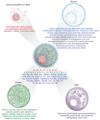A unified vision of the building blocks of life
- PMID: 18758488
- PMCID: PMC2892900
- DOI: 10.1038/ncb0908-1015
A unified vision of the building blocks of life
Figures

References
-
- Shriner D, Vaughan LK, Padilla MA, Tiwari HK. Problems with genome-wide association studies. Science. 2007;316:1840–1842. - PubMed
-
- Wright L. Looking deep, deep into your genes. Onearth. 2007;29:32–35.
-
- Garber K. The elusive ALS genes. Science. 2008;319:20. - PubMed
-
- Smyth S, Heron A. Diabetes and obesity: the twin epidemics. Nature Med. 2005;12:75–80. - PubMed
-
- Gagneux P, Varki A. Evolutionary considerations in relating oligosaccharide diversity to biological function. Glycobiology. 1999;9:747–755. - PubMed
Publication types
MeSH terms
Substances
Grants and funding
LinkOut - more resources
Full Text Sources

